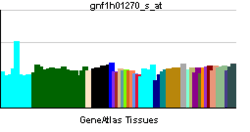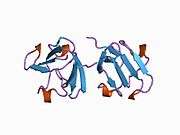CRYGS
Beta-crystallin S is a protein that in humans is encoded by the CRYGS gene.[3]
Crystallins are separated into two classes: taxon-specific, or enzyme, and ubiquitous. The latter class constitutes the major proteins of vertebrate eye lens and maintains the transparency and refractive index of the lens. Since lens central fiber cells lose their nuclei during development, these crystallins are made and then retained throughout life, making them extremely stable proteins. Mammalian lens crystallins are divided into alpha, beta, and gamma families; beta and gamma crystallins are also considered as a superfamily. Alpha and beta families are further divided into acidic and basic groups. Seven protein regions exist in crystallins: four homologous motifs, a connecting peptide, and N- and C-terminal extensions. Gamma-crystallins are a homogeneous group of highly symmetrical, monomeric proteins typically lacking connecting peptides and terminal extensions. They are differentially regulated after early development. This gene encodes a protein initially considered to be a beta-crystallin but the encoded protein is monomeric and has greater sequence similarity to other gamma-crystallins. This gene encodes the most significant gamma-crystallin in adult eye lens tissue. Whether due to aging or mutations in specific genes, gamma-crystallins have been involved in cataract formation.[3]
References
Further reading
- Graw J (1998). "The crystallins: genes, proteins and diseases". Biol. Chem. 378 (11): 1331–48. doi:10.1515/bchm.1997.378.11.1299. PMID 9426193.
- Slingsby C, Clout NJ (2000). "Structure of the crystallins". Eye (London, England). 13 ( Pt 3b): 395–402. doi:10.1038/eye.1999.113. PMID 10627816.
- Zarina S, Abbasi A, Zaidi ZH (1992). "Primary structure of beta s-crystallin from human lens". Biochem. J. 287 (Pt 2): 375–81. doi:10.1042/bj2870375. PMC 1133175
 . PMID 1445197.
. PMID 1445197.
- Brakenhoff RH, Aarts HJ, Reek FH, et al. (1991). "Human gamma-crystallin genes. A gene family on its way to extinction". J. Mol. Biol. 216 (3): 519–32. doi:10.1016/0022-2836(90)90380-5. PMID 2258929.
- Meakin SO, Du RP, Tsui LC, Breitman ML (1987). "Gamma-crystallins of the human eye lens: expression analysis of five members of the gene family". Mol. Cell. Biol. 7 (8): 2671–9. PMC 367883
 . PMID 3670288.
. PMID 3670288.
- Smith JB, Yang Z, Lin P, et al. (1995). "The complete sequence of human lens gamma s-crystallin". Biochem. J. 307 (Pt 2): 407–10. doi:10.1042/bj3070407. PMC 1136663
 . PMID 7733876.
. PMID 7733876.
- Zarina S, Slingsby C, Jaenicke R, et al. (1995). "Three-dimensional model and quaternary structure of the human eye lens protein gamma S-crystallin based on beta- and gamma-crystallin X-ray coordinates and ultracentrifugation". Protein Sci. 3 (10): 1840–6. doi:10.1002/pro.5560031023. PMC 2142617
 . PMID 7849599.
. PMID 7849599.
- Lampi KJ, Ma Z, Shih M, et al. (1997). "Sequence analysis of betaA3, betaB3, and betaA4 crystallins completes the identification of the major proteins in young human lens". J. Biol. Chem. 272 (4): 2268–75. doi:10.1074/jbc.272.4.2268. PMID 8999933.
- Wistow G, Sardarian L, Gan W, Wyatt MK (2000). "The human gene for gammaS-crystallin: alternative transcripts and expressed sequences from the first intron". Mol. Vis. 6: 79–84. PMID 10837510.
- Purkiss AG, Bateman OA, Goodfellow JM, et al. (2002). "The X-ray crystal structure of human gamma S-crystallin C-terminal domain". J. Biol. Chem. 277 (6): 4199–205. doi:10.1074/jbc.M110083200. PMID 11706012.
- MacCoss MJ, McDonald WH, Saraf A, et al. (2002). "Shotgun identification of protein modifications from protein complexes and lens tissue". Proc. Natl. Acad. Sci. U.S.A. 99 (12): 7900–5. doi:10.1073/pnas.122231399. PMC 122992
 . PMID 12060738.
. PMID 12060738.
- Lapko VN, Purkiss AG, Smith DL, Smith JB (2002). "Deamidation in human gamma S-crystallin from cataractous lenses is influenced by surface exposure". Biochemistry. 41 (27): 8638–48. doi:10.1021/bi015924t. PMID 12093281.
- Lapko VN, Smith DL, Smith JB (2003). "S-methylated cysteines in human lens gamma S-crystallins". Biochemistry. 41 (50): 14645–51. doi:10.1021/bi0267700. PMID 12475213.
- Strausberg RL, Feingold EA, Grouse LH, et al. (2003). "Generation and initial analysis of more than 15,000 full-length human and mouse cDNA sequences". Proc. Natl. Acad. Sci. U.S.A. 99 (26): 16899–903. doi:10.1073/pnas.242603899. PMC 139241
 . PMID 12477932.
. PMID 12477932.
- Annunziata O, Ogun O, Benedek GB (2003). "Observation of liquid–liquid phase separation for eye lens γS-crystallin". Proc. Natl. Acad. Sci. U.S.A. 100 (3): 970–4. doi:10.1073/pnas.242746499. PMC 298710
 . PMID 12529503.
. PMID 12529503.
- Craghill J, Cronshaw AD, Harding JJ (2004). "The identification of a reaction site of glutathione mixed-disulphide formation on gammaS-crystallin in human lens". Biochem. J. 379 (Pt 3): 595–600. doi:10.1042/BJ20031367. PMC 1224128
 . PMID 14763903.
. PMID 14763903.
- Gerhard DS, Wagner L, Feingold EA, et al. (2004). "The Status, Quality, and Expansion of the NIH Full-Length cDNA Project: The Mammalian Gene Collection (MGC)". Genome Res. 14 (10B): 2121–7. doi:10.1101/gr.2596504. PMC 528928
 . PMID 15489334.
. PMID 15489334.
- Sun H, Ma Z, Li Y, et al. (2006). "Gamma-S crystallin gene (CRYGS) mutation causes dominant progressive cortical cataract in humans". J. Med. Genet. 42 (9): 706–10. doi:10.1136/jmg.2004.028274. PMC 1736139
 . PMID 16141006.
. PMID 16141006.
PDB gallery |
|---|
|
| 1a7h: GAMMA S CRYSTALLIN C-TERMINAL DOMAIN |
| 1ha4: GAMMAS CRYSTALLIN C TERMINAL DOMAIN FROM HOMO SAPIENS |
|
|


 . PMID 1445197.
. PMID 1445197. . PMID 3670288.
. PMID 3670288. . PMID 7733876.
. PMID 7733876. . PMID 7849599.
. PMID 7849599. . PMID 12060738.
. PMID 12060738. . PMID 12477932.
. PMID 12477932. . PMID 12529503.
. PMID 12529503. . PMID 14763903.
. PMID 14763903. . PMID 15489334.
. PMID 15489334. . PMID 16141006.
. PMID 16141006.
